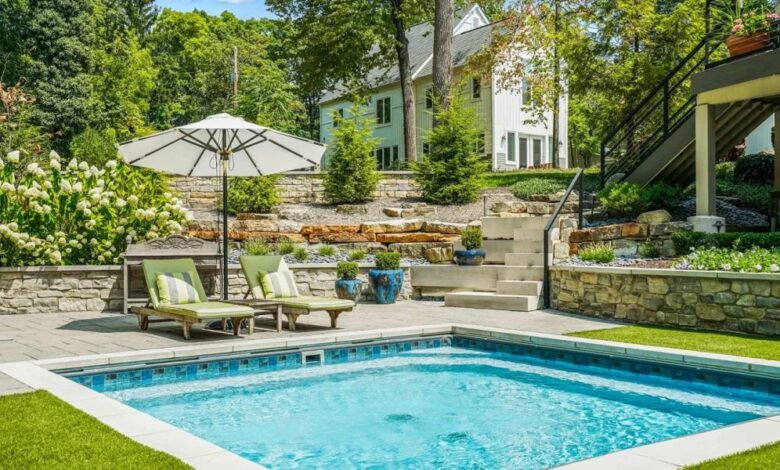Using Landscaping to Create a Natural Inground Pool Perimeter

Creating a beautiful inground pool is only part of the story. What truly sets a custom pool apart is how well it blends with the surrounding environment. One of the best ways to achieve this seamless look is by using landscaping to form a natural perimeter. With the right mix of plants, textures, and design elements, your pool area can feel more like a tucked-away oasis than a manmade feature in the backyard.
Whether you’re looking to soften the edges of a concrete pool or transform your space into a backyard escape, thoughtful landscaping is key. Let’s explore how to create a natural-looking pool perimeter that enhances your outdoor space and makes your pool feel like it belongs in the landscape.
Start with the Right Layout
Before you start planting, take a moment to consider the layout of your pool and surrounding yard. Think about how people will move around the space, where you want shade or sun, and how much visibility you want from the house. A natural perimeter should follow the lines of your pool organically, avoiding harsh angles or overly symmetrical borders.
If your backyard slopes or includes existing trees, use that to your advantage. Integrating the pool into the natural grade or building around mature trees can create a truly custom look. Let the landscape guide you—it’s much easier to design a pool that works with nature than to fight against it.
Use Layered Planting for Depth
A natural pool perimeter benefits from the depth and texture that layered planting provides. Think of it like painting with plants. Start with taller shrubs or ornamental grasses in the background, then add medium-height foliage, and finish with low-growing ground covers or flowering plants near the water’s edge.
Native plants are especially good choices here. They not only blend effortlessly into the local landscape but also require less maintenance and water. Varieties like lavender, salvia, and creeping thyme are great for sunny poolside spots, while ferns, hostas, and hydrangeas thrive in shadier corners.
Incorporate Natural Materials
Stone, gravel, and wood can all contribute to a more organic pool design. Swap out stark concrete borders for flagstone or natural pavers, or build a stepping path from your patio to the pool using irregular stones and pea gravel.
A wooden deck can also help blend the pool into the backyard, especially when paired with surrounding trees or planted borders. Just make sure to choose materials that can withstand water exposure and summer sun. The goal is to create transitions that feel soft and natural, not rigid or sterile.
Create Privacy with Greenery
Tall hedges, bamboo, or fast-growing trees like arborvitae can provide instant privacy while enhancing the natural vibe of your pool area. Rather than relying on fences or walls, use greenery to create secluded pockets of space.
For a more tropical look, mix in palms, elephant ears, or banana plants—perfect for humid or warmer climates. If you’re in a drier area, desert-adapted options like agave, red yucca, and desert willow offer striking forms without a heavy water bill.
Add Natural Accents and Features
Beyond the basics of plants and materials, small details can make a big difference. A rock waterfall, dry creek bed, or stone bench tucked under a tree all help make your pool feel like part of the landscape.
Even your pool lighting can play a role. Use soft, low-voltage lights hidden among the plants to create an ambient glow at night. This helps preserve the natural look while still offering safety and visibility after sunset.
Maintain the Balance Between Wild and Tidy
While you want the space to feel organic, it shouldn’t become overgrown or chaotic. A successful natural pool perimeter strikes a balance between wild beauty and intentional design. Regular pruning, mulching, and occasional thinning will keep the landscape looking polished without becoming overly manicured.
It’s also smart to leave some open areas near the pool for lounge chairs, umbrellas, or dining sets. Too much planting too close to the pool can make maintenance tricky and crowd out usable space.
Let Nature Lead the Way
Landscaping your inground pool with a natural perimeter doesn’t mean you have to go full jungle. With thoughtful planning and a few well-placed design elements, you can soften the lines of your pool and help it blend harmoniously into your yard. If you are looking for ideas for inground pools in Huntsville, there are companies who can help. By choosing native plants, layering textures, and incorporating natural materials, you’ll create an inviting retreat that feels both refreshing and grounded in nature.
In the end, it’s not just about what surrounds your pool—it’s about how it all works together. Let the landscape shape the experience, and your backyard pool can become more than a feature; it can become a feeling.



